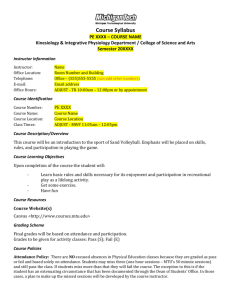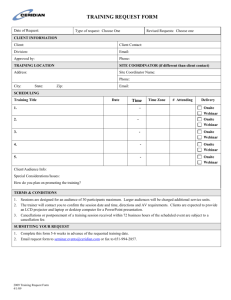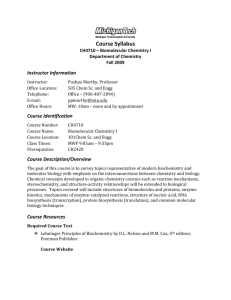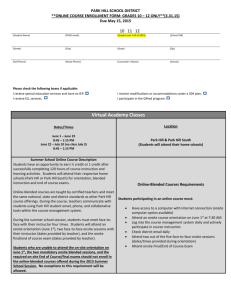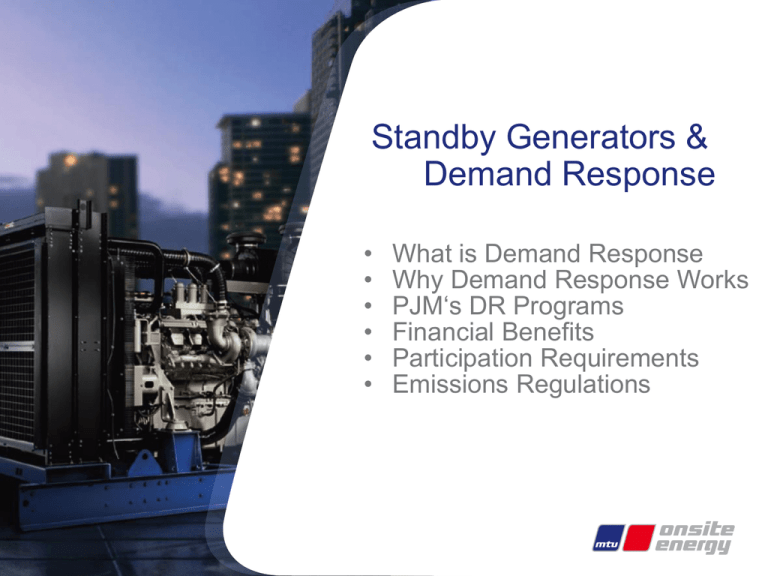
Standby Generators &
Demand Response
•
•
•
•
•
•
What is Demand Response
Why Demand Response Works
PJM‘s DR Programs
Financial Benefits
Participation Requirements
Emissions Regulations
Demand Response
FERC & Electric Utility Support
• “Demand Response creates a more efficient grid and
allows consumers to lower their bills. When you combine
those two things together you’ve got a powerful engine
that can start and maintain the smart grid”.
– FERC Chairman, Jon Wellinghoff, 2010 SmartGrid Today.
• “Demand response and energy efficiency really have the
highest potential to transform the way we consume
electricity”.
– Quote from Brett Perlman, former member of the Texas Public
Utilities Commission, at the 2012 National Electricity Conference in
Washington, DC.
Page 2 / MTU Onsite Energy / 3/22/2016
© MTU Onsite Energy GmbH / All rights reserved
Demand Response
Definitions
• Demand Response is the voluntary and temporary
reduction of electricity usage in response to electrical
power system stress or economic signals from retail rates.
• Reductions in electricity usage can be achieved by turning
off building loads (lights, air conditioning, fans…) or by
transferring building load to standby generators.
• Financial incentives exist across the US to encourage
Demand Response participation which is needed to help
lower peak demands.
Page 3 / MTU Onsite Energy / 3/22/2016
© MTU Onsite Energy GmbH / All rights reserved
NYISO 2011 Demand Peak
Utilizing DR for Peak Management
Page 4 / MTU Onsite Energy / 3/22/2016
© MTU Onsite Energy GmbH / All rights reserved
Demand Response
Demand Side Management
• DR provides electrical utilities and grid operators a tool to
more efficiently balance electrical supply and demand.
– Quickly reduces critical peak load demands.
– Minimizes transmission congestion / constraints.
• Electricity demand continues to grow while supply side
solutions are becoming increasingly limited due to:
– High construction costs,
– Environmental concerns,
– Transmission capacity constraints.
• Traditional pricing structure also presents a challenge.
– Most consumers pay a fixed price, while producers are paid
based on a variable clearing price creating inelastic demand.
Page 5 / MTU Onsite Energy / 3/22/2016
© MTU Onsite Energy GmbH / All rights reserved
The Electricity Marketplace
Price Determined by Load
• All resources are paid the clearing price.
Supply Resources
250
200
150
$/MWh
100
50
Hydro, Nuclear
0
0
10
20
30
Gas
CC
Coal
40
50
60
70
80
90
GWs
Page 6 / MTU Onsite Energy / 3/22/2016
© MTU Onsite Energy GmbH / All rights reserved
100
110
120
130
Peakers
140
150
160
170
180
The Electricity Marketplace
Inelastic Demand Curve
Page 7 / MTU Onsite Energy / 3/22/2016
© MTU Onsite Energy GmbH / All rights reserved
PJM Demand Response Programs
Operational Time Requirements
Time of Day
Response Time
Duration
Frequency
Total Hours /
Year
Capacity (DR)
~ 2 - 6pm
½ - 3 Hours
2 – 6 Hours
1 – 10 Times /
Year
2 – 40 Hours
Ancillary /
Synch
Reserves
Anytime
24 / 7
10 Minutes
10 Minutes –
1 Hour
2 – 3 Times /
Month
12 – 20 Hours
Economic /
Price
Voluntary
Day-Ahead or
Day-Of
Voluntary
Voluntary
10 to 40 Hours
Peak
~ 2 – 6pm
1 – 2 Hours
1 – 2 Hours
10 – 15 Times /
Year
10 – 20 Hours
Page 8 / MTU Onsite Energy / 3/22/2016
© MTU Onsite Energy GmbH / All rights reserved
Demand Response Programs
Capacity Revenue Opportunity
2012 ISO Payments: $ per MW-yr
(Typical DR Aggregator Take ~25%)
.
Ontario
$70,000 $160,000
NYISO ROS
$24,000
ISONE
$60,000
NYC (Zone J)
$60,000 $150,000
PJM
$6,000 - $62,000
CAISO
$48,000 - $62,000
ERCOT
EILS - $60,000
LaaR - $90,000
Page 9 / MTU Onsite Energy / 3/22/2016
© MTU Onsite Energy GmbH / All rights reserved
Duke/PE & SCG&E
$30,000 - $42,000
Demand Response Programs
PJM Synch Reserve Revenue
Synch payments in Eastern PJM ~$50,000 / MWyr.
Page 10 / MTU Onsite Energy / 3/22/2016
© MTU Onsite Energy GmbH / All rights reserved
Demand Response Programs
Economic
• Economic demand response – load reduction performed
when energy market price is higher than cost of generation.
• Simple run analysis based on the spread between local
energy prices and operational (fuel) costs.
–
When energy price > fuel cost, run and keep the spread.
– When energy price < fuel cost, don’t run.
• FERC Order 745 requires RTOs to pay demand resources
the full LMP for load reductions.
– Order 745 lowers run costs by up to 50%
• Economic DR revenue potential with Order 745 ranges
between $5,000 and $25,000 / MW-year.
Page 11 / MTU Onsite Energy / 3/22/2016
© MTU Onsite Energy GmbH / All rights reserved
Demand Response Programs
Economic Opportunity: Avg cents/kWh
Page 12 / MTU Onsite Energy / 3/22/2016
© MTU Onsite Energy GmbH / All rights reserved
Demand Response Participation
Using Standby Generators
• Understand your air permit.
• If you don’t have an air permit, you’ll need to get one.
• Standby generator air permits vary considerably by state
and by application. Commonly categorized as:
– Emergency – only operated during loss of utility power and during
system operational testing events.
– Non-emergency – Anything other than emergency, typically limited
by annual allowable operating hours.
• Air permitting requirements:
– Federal: RICE NESHAP, NSPS, Tier 4, Tier 2…
– State Requirements – always trump Fed, most often more stringent
• Customer’s can only market their curtailable load.
Page 13 / MTU Onsite Energy / 3/22/2016
© MTU Onsite Energy GmbH / All rights reserved
Page 14 / MTU Onsite Energy / 3/22/2016
© MTU Onsite Energy GmbH / All rights reserved
DEMAND RESPONSE PARTICIPATION
REQUIREMENTS
Definition of Emergency:
• Emergency – when power is unavailable due to failure/loss of utility
power beyond reasonable control of facility; not including storm avoidance.
• Federal Definitions – vary by regulation.
• Subpart IIII – strictly emergency operation.
• Subpart JJJJ & ZZZZ – allows for 50 hours per year for non-emergency
operations (testing), but no peak shaving; allows for 15 hours per year for
emergency DR participation.
• Definitions vary by state.
• DC, PA, NJ and DE – strictly for emergency, maintenance and testing; aftertreatment required for emergency demand response and any other DR.
• MD and VA – Allow operation in emergency demand response; anything else
requires after-treatment.
Page 15 / MTU Onsite Energy / 3/22/2016
© MTU Onsite Energy GmbH / All rights reserved
Demand Response Participation
Emergency Permitted Generators
• EPA Statement regarding emergency generators: “Engine
cannot be used for peak shaving or as part of financial
arrangement with another entity, except 15 of the 50 nonemergency hours / year can be used for demand response
in emergency situations (e.g., imminent blackout)”
• EPA / DR aggregator case pending which may increase
emergency exception hours to 60 per year.
• States still have jurisdiction over whether or not they allow
emergency generator to participate in any Demand
Response program.
• New Jersey – does not allow customers with emergency
generators to participate in any PJM Demand Response program.
Page 16 / MTU Onsite Energy / 3/22/2016
© MTU Onsite Energy GmbH / All rights reserved
New Generator Set Purchase Considerations
DR Ready Packages
• Proven emissions after-treatment technology to meet state
specific emissions requirements.
• Complete system monitoring.
• Closed transition load transfer capabilities allow for easier
and safer DR participation with automated record keeping.
• Multi-year maintenance and warranty contracts minimize
owning and operating risk.
• Emissions compliance testing and air permitting assistance
provided when needed.
• Financing packages and lease to own options.
Page 17 / MTU Onsite Energy / 3/22/2016
© MTU Onsite Energy GmbH / All rights reserved
Standby Generation
More Than Just Emergency Power
• A valuable revenue stream from otherwise dormant standby
power generation equipment.
• Simple system requirements necessary for participation.
• Improved data analytics with remote monitoring, smart
metering and web-based reporting.
• Proactive emergency preparation with advanced notice of
grid stress.
• Corporate social responsibility and public recognition; helps
“keep the lights on” and the grid more efficient and
operational for everyone.
Page 18 / MTU Onsite Energy / 3/22/2016
© MTU Onsite Energy GmbH / All rights reserved
MTU Onsite Energy
Energy Management Initiative
• Electrical utility and Federal programs demonstrate the
need for increased demand side management.
• Distributed generation will continue to be an integral part of
lowering peak demands.
• A good energy management strategy can improve the
bottom line of a company and the broader community.
Page 19 / MTU Onsite Energy / 3/22/2016
© MTU Onsite Energy GmbH / All rights reserved
Demand Response:
Maximizing value from
standby generation.
Page 20 / MTU Onsite Energy / 3/22/2016
© MTU Onsite Energy GmbH / All rights reserved



